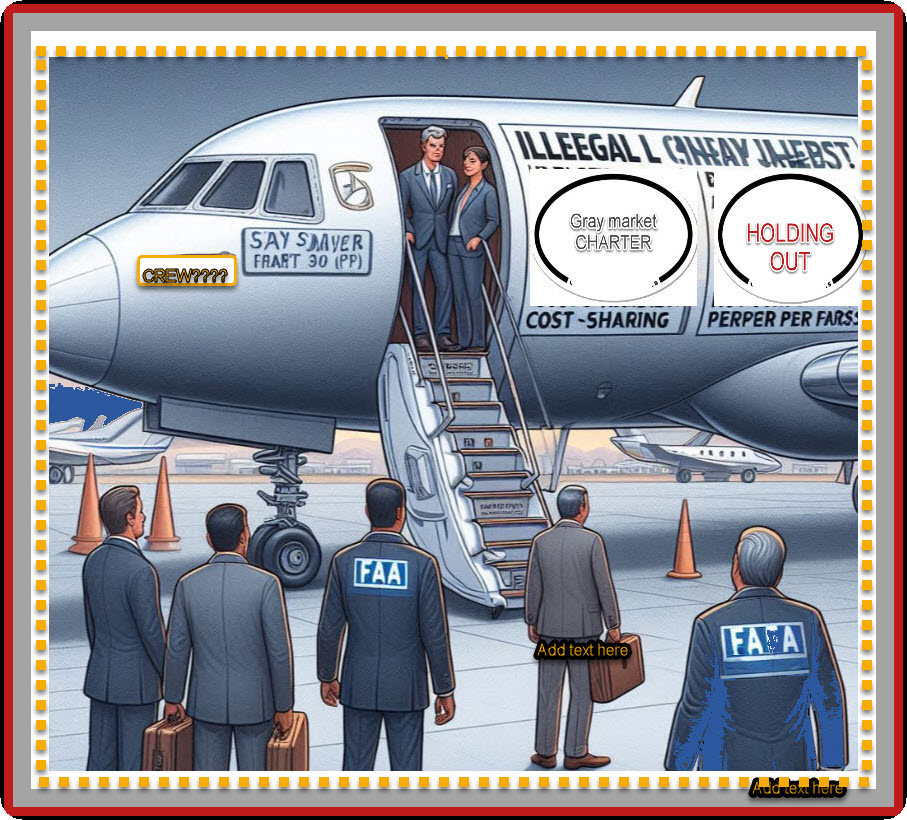FAA special team attacking GRAY Charters; time to get it right before being BLACKBALLED ?

 has published a very instructive 1,600 word article that delineates the vagaries of what an ILLEGAL CHARTER is or may be or is not. The experts explain different interpretative approaches to determining whether flight meets the FAA’s requirements. As clear as this guidance may be, even the more sophisticated passengers who may be considering hiring an aircraft will have a challenging time differentiating the good from the bad.
has published a very instructive 1,600 word article that delineates the vagaries of what an ILLEGAL CHARTER is or may be or is not. The experts explain different interpretative approaches to determining whether flight meets the FAA’s requirements. As clear as this guidance may be, even the more sophisticated passengers who may be considering hiring an aircraft will have a challenging time differentiating the good from the bad.
Unfortunately, the cover picture is fictional. There are no consumer protection lables for these purchases. The authors point out that the FAA IS MORE AGGRESSIVELY TRYING TO RID THE MARKET OF THESE OPERATORS. To attack these invidious operators, the FAA has sent out into the field a SPECIAL EMPHASIS INVESTIGATIONS TEAM (SEIT) .Typically these units are staffed with highly sophisticated investigators. The usual composition of these crack teams are backed by FAA lawyers who are skilled at making infinitesimally precise judgments about
- whether the “aircraft operating certificate” was appropriate,
- whether the “holding out” scheme (even with high tech a password-protected website or a members-only group) violates the statute,
- whether the cost-sharing allocations were properly calculated;
The article below was written for prospective charter customers, not the aircraft owner, fractional operator, or the pilots. If SEIT’s search for violators is successful (almost guaranteed by its commission name) , the consequences will be inflicted on the people on the flight side of these transactions. The regulatory sanctions MIGHT include: IF
-
-
- If the pilots are found as knowing or should have known that the flight was illegal, their flight licences could be suspended or even terminated. A BIG DEAL.
- If the owner and/or a management firm are guilty of violating an FAR, fines are highly likely and the size of such penalties can be staggering. The formula for calculating the fine is as follows:
- $11,000 – $33,000 per violation
-
TIMES
-
-
- EACH FAR VIOLATION, could be multiple sections
-
TIMES
-
-
- EACH FLIGHT to/from during continuous illegal activity counts as event
-
A VERY BIG DEAL
N.B. the biggest penalty could be non-regulatory, if an illegal charter crashes and the insurer learns that the flight was beyond the FAA authority for it, the INSURANCE COMPANY could deny coverage based on a standard exclusion of a policy
Aside from paying a large fine and the attendant bad publicity, an FAA determination of non-compliance is a historically standard basis for refusing to issue a license to a pilot and to deny an application for a Part 135 ticket.
Once the SEIT team finds that you have not met the FARs, the likelihood of seeking to recover your business by seeking the REQUIRED FAA AUTHORITY DIMINISHES SUBSTANTIALLY and at best, will REQUIRE A PROLONGED CERTIFICATION PROCESS TO DEMONSTRATE THAT THE PAST WILL NOT BE REPEATED.
For operators who are flying in the scud of the FARs, particularly with the SEIT out to punish a GRAY Charter operator in a HIGH PROFILE case to send out a deterrant threat, NOW IS THE TIME TO SEEK the appropriate FAA ticket. The process is not nearly as burdensome as feared and the cost of getting your aurthority right is much less than the likely outcome of the SEIT campaign!!!
JDA can help with its FAA Master Change Process Document which is a structured system safety-based approach to assess the design and performance of the certificate holder’s proposed change(s) which includes 5 Phases (Initial Inquiry, Application,Element Design Assessment, Element Performance Assessment and FAA Administrative Functions).
FAA working ‘aggressively’ to shut down illegal charter operations as problem persists
September 16, 2025
The FAA says it “works aggressively” to identify and shut down “rogue operators” who operate illegal charters. It also says it HELPS PASSENGERS ENSURE THE CHARTER COMPANY THEY HIRE IS LEGITIMATE.
The comments have come in the wake of news, first published by The Wall Street Journal, that spare seats on private jet flights were being sold via private messaging groups such as WhatsApp and Telegram.
The FAA confirmed it is aware of the existence of these groups.
“Illegal air charters pose a serious safety hazard to the traveling public,” an FAA spokesperson told CJI. “It’s important people verify the legitimacy of their charter operator before booking their flight, and THE FAA HAS TOOLS TO HELP PASSENGERS DO THAT.
“Legitimate charters require A HIGHER LEVEL OF FAA PILOT TRAINING AND QUALIFICATION, AIRCRAFT MAINTENANCE AND OPERATIONAL SAFETY RULES. Illegal charter operators do not follow these robust safety requirements.”
But first, the issue itself. As society’s dependence on secure messaging applications has grown, so have the opportunities for their use. Post-Covid pandemic, sales by the seat on charter flights have increased significantly as new entrants to the industry, as well as existing users, look for ways to save.
“Aircraft are expensive — anywhere from $5,000 to $15,000 per hour to operate,” David M. Hernandez, shareholder at Vedder Price and the Business Aviation and Regulation Sub-Practice Group Chair, told CJI. “If you can get someone to split that cost with you, it is a very tempting way to save thousands of dollars per trip.”
Flying up and down the US east coast is one of the most popular charter routes in the country. This means it attracts a significant level of interest from those hoping to fill seats on their flight.
Hernandez said: “You get some high-net-worth individuals on these flights, that can easily afford it, but would rather save the money. You don’t become a high-net-worth individual by spending money liberally. In addition to being a cost-saving measure, these flights can also act as networking opportunities, where people can meet and mingle with other high-net-worth individuals.”
Levels of operation
ILLEGAL CHARTER is defined as any flight for payment that LACKS PROPER SAFETY CERTIFICATIONS — aka an air operator’s certificate (AOC). But there are various levels of operations that fall within the umbrella.
There are groups that will be offering seats on flights conducted through fractional operators, who might offer a place for a percentage of the occupied hourly cost. “That is absolutely illegal under the terms of every fractional contract. You can’t resell fractional flights,” said Hernandez.
Then there are aircraft owners who may offer others to join them on a flight which they are already planning to conduct. Hernandez likens this to crowdsourcing. He says this can be “more problematic” because the person stepping on the aircraft doesn’t know who they’re flying with.
“You DON’T KNOW THE PILOTS, INSURANCE, MAINTENANCE — YOU DON’T KNOW ANYTHING. These are what I call ‘private illegal charter.’ At least with big fractionals, like NetJets and FlexJet, you know that the flight is being operated by someone more reputable with the proper certifications and safeguards,” said Hernandez.
Finally, there are the “one-offs,” who don’t own an aircraft and are looking to spread the cost of chartering. “They’re the ‘fake it til you make it’ guys, the ‘crypto bro’ crew and such like. They’re the ones who rent a jet on the cheap and they need someone to come in with them because they really can’t afford $20,000 to $30,000 each way,” explained Hernandez.
“That is the scariest because it is hard to figure out whether or not there is any due diligence going on. While people just hop on and expect it to be safe,” he added.
Part 380 considerations
Jeffrey Reis, founder of MyFlight Advisor, says that even when charters are booked legally, people can get into trouble when they then start advertising seats via messaging groups.
“That is where we run into PART 380 REGULATIONS FOR PUBLIC CHARTER. These individuals hold out much like an airline does, but that comes with a very specific set of rules,” he said.
To legally run a public charter, an individual is required to post a bond, publish flight schedules and actually operate once those schedules are made public. They also have to qualify as an indirect air carrier and contract with a certified direct air carrier.
The key issue comes down to what regulators call “HOLDING OUT.” If publicly advertising seats — for example, saying there are six available on a certain day at a certain price — that counts as holding out. But if access is restricted, through a password-protected website or a members-only group, then it falls into a legal grey area over whether it still qualifies as holding out, said Reis.
“That’s why some companies offering public charters are trying to run things within closed groups, then seek legal interpretations claiming it isn’t public advertising. The distinction is important because the law specifically defines what counts as a public promotion,” he explained.
As a result, many people involved don’t even realize they might be breaking rules. “They think, ‘I booked a Part 135 charter and I’m just splitting costs’. But that’s where the problem arises: violating Part 135 rules is one issue – illegal charter – and breaking Part 380 ‘holding out’ rules is another. They’re separate regulatory violations, even though people often lump them together,” Reis added.
Safety misconceptions
The expectation that stepping on a charter aircraft is just as safe as taking a commercial flight is one of the biggest misconceptions held by those buying seats through private messaging groups. Commercial operations are certified under FAA FAR Parts 121 and 135, and they are heavily regulated
“I think people are, in part, woefully clueless. They just assume that everything is OK,” said Hernandez. “Now, granted, the vast majority of these flights are usually safe. Pilots have no desire to crash, but accidents do happen.”
The biggest issue the FAA has in tackling the use of private messaging groups for seat selling is that it’s regulations only apply to OPERATORS, AIRCRAFT AND PILOTS. “We do not have authority over private messaging apps,” said an agency spokesperson.
To combat this, the FAA said it conducts frequent outreach to the passenger, operator, and pilot community to ensure they know the rules that apply to charter operations. This includes social media messaging, collaboration with foreign regulators and trade associations — like the National Air Transportation Association — and providing passengers with resources such as a list of licensed air charter operators.
The FAA also formed SPECIAL EMPHASIS INVESTIGATIONS TEAM to investigate complex cases of illegal charter. The agency may also take enforcement action and levy fines against illegal charter operations.
Despite this action, illegal charter incidents are potentially occurring more than ever. Hernandez said there likely could be hundreds of “scams” going on right now, but they never end up in court due to their illegality.
“You can’t litigate illegal activity, so your rights and responsibilities are extremely limited,” he explains. “The public is only going to find out when there is an accident, incident or someone gets prosecuted by the FAA or FBI. But, if and when someone is caught engaging in this activity, it will be very public and the sanctions will likely be severe.
“Then there will be a lot of ‘I told you so’s,’ because the industry knows it is wrong. I think what is problematic is that people involved in this are unaware passengers think they’re getting a great deal. They don’t know what they don’t know.”
Hernandez says the FAA, and air regulators in general, are reactive in nature. He believes the agency could be more proactive without overstretching itself.
“When every Part 135 or Part 91 flight lands at Naples or Opa-locka, have an FAA inspector on the runway to ask about the nature of the flight,” he suggested. “Every flight plan is filed with the FAA. If it’s Part 135, they know the passengers. But if it’s 91, all you have to do is focus on the flights. Look at the flight plans, and if the names of the passengers aren’t related, that’s a red flag.”
Legal ways to share
There are ways to legally spread the cost of a flight.
If Person A books a charter flight with Operator B and then decides to split the cost with a few friends — a small group known to each other where Person A is the main passenger and the others are listed on the booking — that setup is legal as long as it follows the rules, said Reis. “The key is that it’s internal, among people who already know each other, and not being advertised publicly,” he added.
However, once the offer goes out to strangers or a wider circle — people who may not have any connection to the main passenger — it quickly falls into a grey area. “At that point, it’s unclear where the legal boundaries lie,” said Reis. “That’s why the safest approach is always to consult an aviation attorney and get an official legal opinion before moving forward.”
Another legal option is joint ownership. Hernandez said a small group of people can collectively buy shares in an aircraft. “That way, they essentially create their own informal fractional program. What they can’t do is sell those ownership shares to outsiders,” he explained.
Digital platforms that work with certified Part 135 operators are another tool. Companies like Katana — a New York-based aggregator of providers that sell seats on business jets — connect passengers with these operators, who then combine multiple customers onto a single flight. “For example, if you’re flying to Miami and flexible within a three- or four-hour window, the operator can match you with others going the same way,” said Hernandez.
With digitisation, this kind of flight-matching has become much more common. “Several companies now sell seats on empty legs or aggregated flights, making it easier for people to share costs legally under Part 135,” he added.


